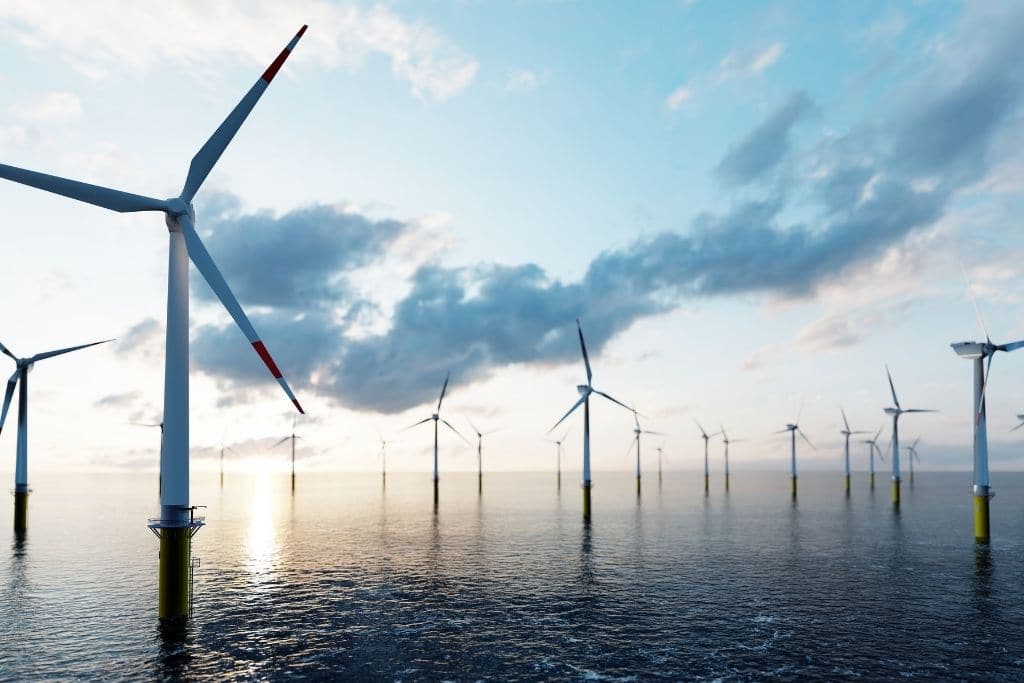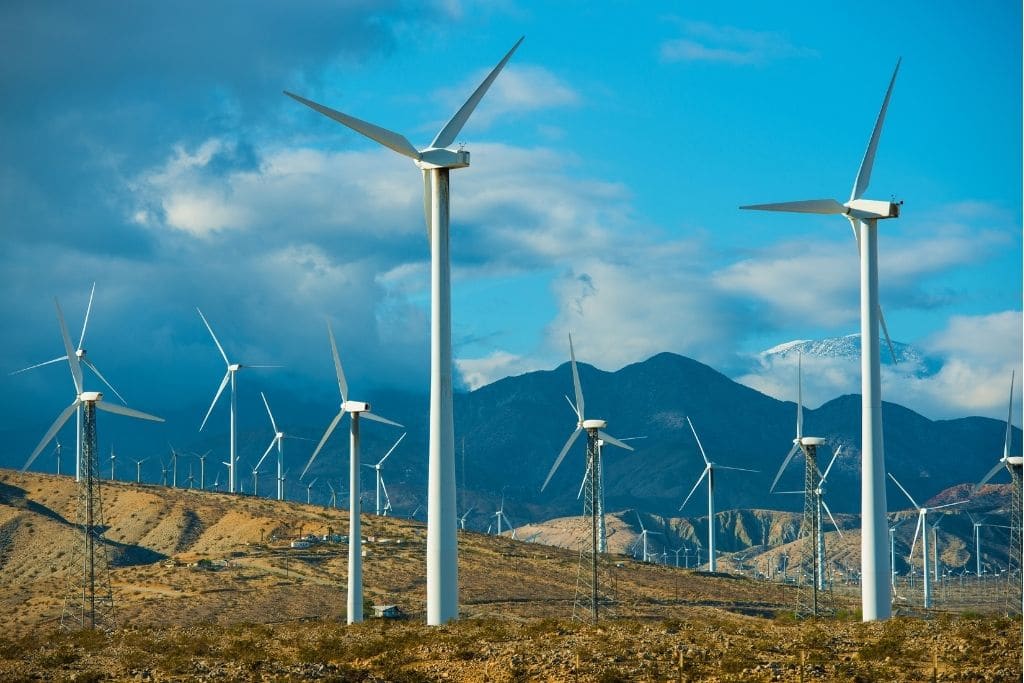Countries around the world are looking to scale up and make the transition to 100% renewable energy to combat global warming and the climate crisis. Wind is an abundant natural resource on Earth that occurs as a result of the sun unevenly heating the surface of the planet. As hot air rises, cooler air moves in to fill the void. Wind has long served as a power source to humans, from powering ships across the sea to farmers relying on windmills to grind their grains and pump water. Today, we use wind turbines – both onshore and offshore – to generate electricity. Large utility-scale wind farms can contribute to the electricity demand for countries while smaller turbines erected in a backyard can produce enough electricity to power a single home and business. With costs on the decline, the wind energy industry is set for a boom. Here are some facts about wind energy and the benefits this renewable energy source offers.
—
Top Facts about Wind Energy
1. Wind Turbine Towers Are As Tall As the Statue of Liberty
A notable feature of wind energy generation is the scale of wind turbines – an average turbine blade is about 200 ft long while turbine towers reach up to 295 ft tall on average. But wind turbines are expected to be built with longer and larger blades, and with taller towers too, to help generate even more power and improve the performance of power generation. In 2020, the average capacity of utility-scale wind turbines installed was 2.75 megawatts, 8% higher than the previous year.
2. Wind Power Generation Does Not Emit Any Greenhouse Gases
One of the best arguments for and facts about wind energy is that its electricity generating process does not produce any planet-warming greenhouse gases, making it a green energy source. However, some emissions do occur during its lifecycle including the building and construction of turbine towers. The making of materials used in the turbines such as steel, concrete, fiberglass, and copper all produce some greenhouse gases at some point. But the carbon footprint of wind power is far lower than fossil fuels like coal; coal’s footprint is almost 90 times larger than that of wind while natural gas is more than 40 times bigger. Overall, wind energy produces around 11g of CO2 per kilowatt-hour of electricity generated, compared with about 980g for coal.
3. Global Onshore Wind Electricity Generation Increased by 11% in 2020
2020 was a big year for the growth of renewables, particularly in wind energy. Onshore wind electricity generation increased by 144 terawatt-hour (TWh) while offshore wind increased by 25 TWh, a 29% climb from the previous year. Overall, 1 592 TWh of electricity were generated from wind installations in 2020, which was 12% more than in 2019. Wind energy capacity (the ability to absorb and store energy) also doubled from 2019, attributed to China and the United States, which together accounted for 79% of global wind deployment.
4. Offshore Wind Could Potentially Generate 18 Times the Current Global Electricity Demand
Based on current technology and market growth, where costs could drop by 40% over the next decade, the International Energy Agency (IEA) projected offshore wind energy has the potential to generate 425,000 TWh of electricity in a year worldwide, which is more than 18 times the global electricity demand of today. Though offshore wind currently makes up only 0.3% of the world’s total power generation, the market is still in its relative infancy with many investors encouraged by wind power’s rapidly declining costs, which already fell by around 9% in 2019.
5. Offshore Wind Can Generate More Electricity with Less Turbines
One of the most notable facts of wind energy is that offshore wind speeds tend to be faster and more consistent than on land, meaning that fewer turbines are needed to generate the same amount or even more electricity, while freeing up land for other purposes without impacting human or terrestrial wildlife activity. But offshore wind remains more costly to construct than its onshore counterparts – up to 20% more expensive, – due to the price of building energy transmission cables out at sea and higher maintenance costs.
If you like these facts about wind energy, you might also like: 12 Solar Energy Facts You Might Not Know About

Some studies have found that offshore wind has potentially harmful effects on marine flora and fauna, as well as birds, fish and marine mammals, especially cetaceans and pinnipeds. In the Greater Wash Area in the UK, for example, there has been noted mortality increases for small bird species from turbines while some harbour seals were noted to be impacted by noise pollution. Other research however suggests that across wind farms, fish biomass is expected to increase, producing “de facto” marine protected areas. This potentially creates a spillover effect of attracting larger fish from the surrounding areas coming to offshore wind farms to feed, which could benefit the fishing industry.
7. China Is By Far The Biggest Producer of Wind Energy
Despite being the world’s largest greenhouse gas emitter, China is also the world leader when it comes to wind energy, producing more than a third of global wind power generation and capacity. In 2020, the country’s onshore wind capacity almost tripled from its 2019 levels to reach nearly 69 GW. To compare, the entire European bloc increased 8 GW during the same period. China is followed by the US, Germany – which has recently passed a law requiring an average of 2% of percent of all state and community lands to be used for wind power, India and Spain respectively as the top wind energy producers in the world.
8. Wind Energy Sector Will Employ 4 Million People by 2030
According to the Global Wind Energy Council, the wind energy sector can generate employment for four million people globally by 2030 provided that its deployment takes place at a necessary rate. Currently, some 1.3 million people worldwide already work in the wind sector. The need for rapid expansion not only aids the global transition away from fossil fuels towards renewables, but can create more jobs around the world.
9. The Gansu Wind Farm is the Biggest Wind Farm in the World
Also known as the Jiuquan Wind Power Base, the Gansu Wind Farm is located in the west of Gansu province in China, on the outskirts of the Gobi Desert. Once completed, the farm will see 7,000 turbines installed across the Jiuquan, Inner Mongolia, Hebei, Xinjiang, Jiangsu and Shandong provinces, with a capacity of 20GW, making it the world’s largest wind farm. It is capable of producing enough energy to power a small country. The title for the biggest offshore wind farm however, is bestowed upon the Hornsea 2 wind power plant, which is located off the east coast of the UK. When fully operational, the facility will have a capacity of 1.3 GW, or 2.5 GW when combined with Hornsea 1, the plant’s still-operational predecessor.
10. The Biden Administration Set to Deploy 30 GW of Offshore Wind Power by 2030
US President Joe Biden has pledged to halve the country’s carbon emissions by the end of the century. To do so, his administration is scaling up renewable energy investments and deployment, including approving the US’ first commercial-scale offshore wind farm in the waters off Massachusetts’ coastline. Another agreement was made to begin constructing a similar project in the Pacific Ocean lining the coast of California with a long-term plan in place to construct wind farms along nearly the entire US coastline. At the same time, eight East Coast states have set down offshore wind targets that, combined, amount to 40,000 MW by 2040.


















